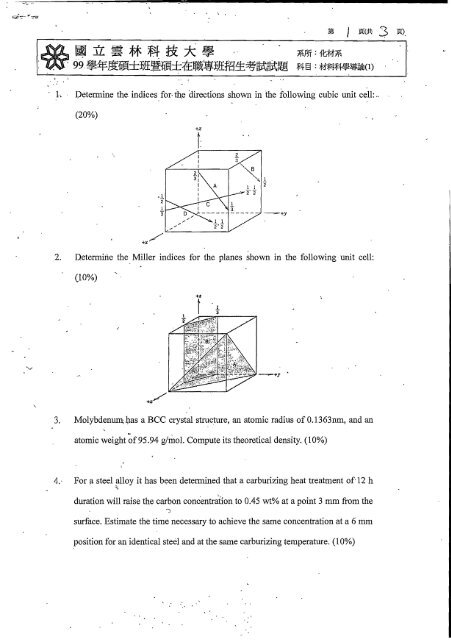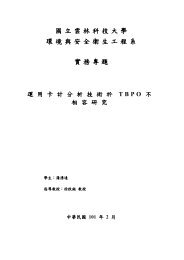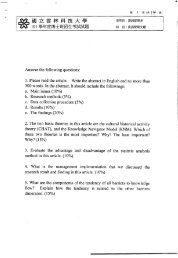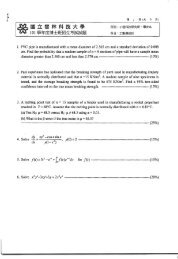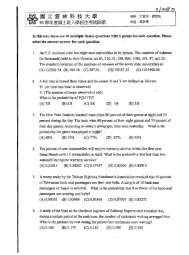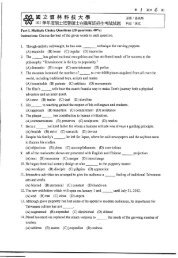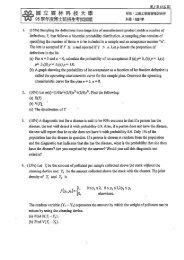2. DeteIDlirie the Miller indices
2. DeteIDlirie the Miller indices
2. DeteIDlirie the Miller indices
Create successful ePaper yourself
Turn your PDF publications into a flip-book with our unique Google optimized e-Paper software.
\ .<br />
L<br />
DeteIDline <strong>the</strong>. <strong>indices</strong> for· ~e directions shown in <strong>the</strong> following cubic unit c~ll:-<br />
(20%)<br />
+z<br />
t<br />
.!<br />
2<br />
1<br />
'3<br />
+x/<br />
<strong>2.</strong> <strong>DeteIDlirie</strong> <strong>the</strong> <strong>Miller</strong> <strong>indices</strong> for <strong>the</strong> planes shown in <strong>the</strong> following unit cell:<br />
(10%)<br />
3. MolybdenUIl1;.b.as a BCC crystal structure, an atomic radius of 0.1363nm, and an<br />
atomic weight ;f95.94 g!mol. Compute its <strong>the</strong>oretical density. (10%)<br />
4.'<br />
For ~ steel alloy it has bt;:en determined thata carburizing heat treatment of12 h<br />
q,<br />
duration will raise <strong>the</strong> carbon concentration to 0.45 wt% at a point 3 mm from <strong>the</strong><br />
surface. Estimate <strong>the</strong> time necessary to achieve <strong>the</strong> same concentration at a 6 mm<br />
position for an identical steel and at <strong>the</strong> same carburizing temperature. (10%)
5. A strip ofchicken skin was excised for mechanical testing in tension. The initial<br />
dimensions of<strong>the</strong> rectangular specimen were 30 mm long and 15 mm wide, with<br />
an average thickness .of 3 mm. The mechanical testing was conducted at a rate of5<br />
mmlsec. The following data were obtained:<br />
.,<br />
Gaugelength(mm)<br />
Force (N)<br />
20.0 · 0.0 ~<br />
20.5<br />
•<br />
0.1<br />
21.0 · 0.3<br />
21.5 0.5<br />
2<strong>2.</strong>0 0.8<br />
2<strong>2.</strong>5 1.1<br />
23.1 1.6<br />
23.6 <strong>2.</strong>0<br />
24.2 <strong>2.</strong>7<br />
24.6 3.6<br />
25:2 4.7<br />
25.7 6;2<br />
26.3 7.9<br />
26.8 9.7<br />
27.4 11.4<br />
"<br />
27.9 1<strong>2.</strong>9<br />
28.5 14.5<br />
29.0 16.4<br />
i<br />
29.6 18.3<br />
30.1 19.6<br />
.<br />
I<br />
I<br />
(a) Calculate <strong>the</strong> engineering stresses and strains from <strong>the</strong> information given and plot<br />
<strong>the</strong> engineering stress-strain curve. Assume that 5 mm of<strong>the</strong> specimen length is<br />
clamped by <strong>the</strong> testing grips at each end, such that <strong>the</strong> initial gauge length of<strong>the</strong><br />
specimen is 20 mm. (10%)<br />
(b) It was found that immediately before <strong>the</strong> last data point, <strong>the</strong> average width of<strong>the</strong><br />
sample was 8 mm and <strong>the</strong> average thickness ~f<strong>the</strong> sample was 0.75 mm.<br />
Considerin~ this information, determine <strong>the</strong> true stress and true strain of<strong>the</strong><br />
sample at <strong>the</strong> last data point. (10%)
~m:ft#~ ~<br />
f4§ : #;jS}~.'(1)<br />
(c) Compare <strong>the</strong> true stress and strain values for <strong>the</strong> final data point with <strong>the</strong><br />
engineering stress and strain values for <strong>the</strong> fmal data point (5%)<br />
6. Calculate <strong>the</strong> density ofa poly( ethylene) sample that is 75% crystalline, kn0Fg<br />
that <strong>the</strong> density of completely amorphous poly(ethylene) is 0.85 g/cm 3 and tlle<br />
density ofcompletely crystalline poly( ethylene) is 1.00 g/cm 3 • (5%)<br />
7. Consider <strong>the</strong> following polymer size fractions ofa given polymer sample:<br />
Fraction<br />
1 <br />
2 <br />
3 <br />
Molecular weight<br />
5000 <br />
10000 <br />
1000000 <br />
.<br />
Number ofCha~<br />
I<br />
1000 j<br />
1000<br />
(a) Calculate <strong>the</strong> number-average molecular weight of<strong>the</strong> polymer. (5%)<br />
3 f<br />
(b) Cal~ulate <strong>the</strong> weight-average molecul~ weight of<strong>the</strong> polymer. (5%) ( .<br />
(c) Which average molecular weight determination did <strong>the</strong> 3 chains ofmolec~'ar<br />
weight 1000000 most significantly affect? Why? (5%)<br />
(d) Calculate <strong>the</strong> polydispersity index of<strong>the</strong> polymer. (5%)<br />
~<br />
i<br />
I<br />
I<br />
I<br />
I<br />
,<br />
;<br />
i<br />
!<br />
I<br />
I<br />
I<br />
I<br />
I .<br />
. I
. r _.<br />
·1<br />
I<br />
m J 11{(:t!i 2<br />
··If J1:'~:f* f-I. ~ "* ¥ .<br />
.99 *1:fJjt1iJi±J!JI~1iJi±:t£~~J!JIm§:.~~~m<br />
1. (16 points) <br />
One mole of gas in a closed system undergoes a four- step <strong>the</strong>rmodynamic CYC1f. Use <br />
<strong>the</strong> data given in <strong>the</strong> followingJable to determine numerical values for <strong>the</strong> missf.ng <br />
quantities, ie., "fill in <strong>the</strong> blanks." (fF~If.f~"~1M*~ I :Mz;t:E:j:T?~~pg:4lt.t.~~) <br />
Step<br />
tiUt/J<br />
Q/J<br />
W/J f<br />
12<br />
-500<br />
?<br />
-6,000 I !<br />
23 ? -3,800 ? I<br />
34 ? -1200 300 41<br />
? I<br />
12341<br />
<strong>2.</strong> ( 14 points) <br />
5,400<br />
?<br />
?<br />
?<br />
,<br />
-1,900 I<br />
A particular power plant operates with a heat-source reservoir at 350°C and a heat-sink reservoir <br />
at 30°C. It has a <strong>the</strong>rmal efficiency equal to 55% of <strong>the</strong> Carnot-engine <strong>the</strong>rmal efficiency for <strong>the</strong> <br />
same temperature. <br />
(a) What is <strong>the</strong> <strong>the</strong>rmal efficiency of<strong>the</strong> plant? ~<br />
(b) To what temperature must <strong>the</strong> heat-source reservoir b.e raised to increase t~e <strong>the</strong>rmal<br />
efficiency of<strong>the</strong> plant to 35%? Again TJis 55% ofth~ Carnot-engine value.:<br />
3. (20 points) <br />
One kmol ofan ideal gas is taken through a four-step cyclic process as displayed on <strong>the</strong> PV <br />
diagram shown below. The gas is subjected successively to an iso<strong>the</strong>rmal expansion at 600 K <br />
from 5 to 4 bar(A to B), an adiabatic expansion to 3 bar(B to C), a constant pr~ssure cooling(C to <br />
!<br />
D), and constant-volume heating(D to A). All processes are assumed reversible. For <strong>the</strong>se<br />
I<br />
processes it is reasonable to assume C p is constant and equal to 30 kJ/kmol . K. Calculate Q, W,<br />
I<br />
tiu, and tih for each step and for <strong>the</strong> entire process.<br />
!<br />
I<br />
P<br />
A<br />
><br />
~<br />
c: !<br />
'"<br />
~ i<br />
I<br />
D<br />
ConstsnlP<br />
v<br />
I<br />
I<br />
I<br />
I<br />
I<br />
I<br />
I
4. (15 points) <br />
A liquid mixture ofspecies 1 and'2 for which <strong>the</strong> mole fraction of species 1 is 0.6 is in <br />
equilibrium with its vapor at 144 °C. Determine <strong>the</strong> equilibrium pressure and vapor composition. <br />
The system forms an azeotrope at 144°C for which <strong>the</strong> species 1 composition is 0.294. At 144 9C, <br />
<strong>the</strong> saturation vapor pressures ofspecies 1 and 2 are 75 kPa and 32 kPa, respectively. The <br />
correlation ofactivity coefficient (y) and liquid composition (x) is given below . <br />
• InYI =Ax;, InY2 = Ax~<br />
5. (15 points) <br />
Mixtures ofCO and CO 2 are to be processed at temperatures between 900 and 1000 K and 1 atm. <br />
Determine under what, conditions solid carbon (C) might deposit according to <strong>the</strong> reaction <br />
CO 2<br />
(g) +C(e) ~ 2CO(g) . Fodhis reaction, <strong>the</strong> equilibrium constants are 0.178 at 900 K and <br />
1.58 at ·1000 K. <br />
6. ( 20 point~ ) <br />
A copper bloc~ having a mass of 10 kg and at a temperature of527°C is placed 'in a well<br />
insulated vessel containing 100 kg ofwater Initially at 17°C. Calculate <strong>the</strong> entropy ch~ges for <br />
<strong>the</strong> block, <strong>the</strong> water and <strong>the</strong> total process. The heat capacities are 4.185 kJ/kg-K for water and <br />
0.398 kJ/kg-K for copper.
. , ,<br />
.fm~L¥:,~ '*f\'fl. 1X * ¥<br />
~FJT : 1t;f%t~ ,<br />
" 99 ¥£P~1i1l±Ji)f~1i1l±1£IM~FJfm~~~~~ f4§ : 1tIliltJtl!<br />
I<br />
~<br />
.<br />
r<br />
I<br />
1<br />
I Jif~ 2<br />
;f·:t~1!! ~ 1{ # 61!!, ' -S-tt 100 ~ Q<br />
tt*1!!Mt1'F$ , Jt#it~1f ~i&f~&$,~;t 1±.r~ ~:t<br />
1:; , l!Af.'~ 1-' tt ~<br />
I<br />
0<br />
1. (15%) Consider a feed CAo = 100, CBo = 300, CIo = 100 to a steady-state CS R. The<br />
iso<strong>the</strong>rmal gas-phase reaction is A + 2B --+ 4R (I: inerts) <br />
If CA= 50 at <strong>the</strong> reactor exit, what is CB, XA>' and XB <strong>the</strong>re? <br />
<strong>2.</strong> (20%) A rapid, first-order liquid reaction is carried out in a fixed-volume, well-mixed<br />
flow reactor under iso<strong>the</strong>rmal conditions. Let
m11. ~ ** W jjt 7::.. ~ , *J5lT : 1t;f;t*<br />
99 ~fj::J!t~±!i)f~~±1:EIll~U'!i)fm~~~~~ f3}l3: 1tI!llJJJ¥<br />
4. Please explain <strong>the</strong> following terms:<br />
(a) space time (5%)<br />
( b) packed bed catalytic reactor (5% )<br />
(c) multiple reactors (5%)<br />
5. A dilute aqueous of A is to be hydrolyzed continuously at 27°C. At this temperature<br />
<strong>the</strong> rate equation for <strong>the</strong> disappearance ofA is<br />
r= O.2C A g molel (cm 3 ) (min)<br />
where C A is concentration of A) The feed rate to be treated is 600 cm 3 /min ,with a<br />
3<br />
A concentration of 2 x 10- 4 g mole I em<br />
• There are two 3-liter and, a 6-liter<br />
reaction vessels available) with excellent agitation devices.<br />
( a) Would <strong>the</strong> conversion be greater if <strong>the</strong> one 6-liter vessel were used as a<br />
steady-flow tank reactor or if <strong>the</strong> two 3-liter vessel were used as reactors in<br />
series ? In <strong>the</strong> latter case all <strong>the</strong> feed would be sent to <strong>the</strong> first reactor and <strong>the</strong><br />
product that would be <strong>the</strong> feed to <strong>the</strong> second reactor. (8%)<br />
(b) Would <strong>the</strong> conversion be increased if a tank-flow reactor of 3-liter were·<br />
followed with a 3-liter tubular-flow reactor? (7%)<br />
6. A solid-catalyzed gaseous reaction has <strong>the</strong> form A + B -> C<br />
Sketch curves of<strong>the</strong> initial rate vs. <strong>the</strong> total pressure for <strong>the</strong> following cases:<br />
( a) The mechanism is <strong>the</strong> reaction between adsorbed A and adsorbed B molecules<br />
on <strong>the</strong> catalyst. The controlling step is <strong>the</strong> surface reaction. (10%)<br />
(b) The mechanism is <strong>the</strong> reaction between adsorbed A and B in <strong>the</strong> gas phases.<br />
The controlling step is <strong>the</strong> surface reaction. (10%)
1. The standard enthalpy of a certain reaction is approximately constant at +188 kJ<br />
mor l from 800 Kup to 1500 K. The standard reaction Gibbs energy is +f.5 kJ<br />
mor l at 1200 K: Estimate <strong>the</strong> temperature at which <strong>the</strong> equilibrium c nstant<br />
becomes 1. (15%)<br />
<strong>2.</strong> The following consecutive reactions ~e elementary.<br />
ka kb<br />
A-Tl-TP <br />
lf<strong>the</strong> initial concentration ofA is [A]o, and no i & P are present initially. <br />
Find <strong>the</strong> rate offormation ofP by using <strong>the</strong> steady-state approximation. (120%)<br />
t<br />
3. Deduce an expression for <strong>the</strong> time it takes for <strong>the</strong> concentration of a SUbstJce (A)<br />
to fall to one-third its initial value ([A] -0) in an nth-order reaction withl a rate<br />
constant (k).<br />
g15%)
.<br />
~ JL. ~ ** f4 fJ( 7\. ~ *Jljf : 1t*'-t*<br />
99 ~£f~1@i±t!Jf!!1@i±?:ElfflX:W:t!Jfm~~~~O f4§: ~J!I!1t~<br />
4. One :n::oie of an ideal monatomic gas expands iso<strong>the</strong>rmally from 1 bar, 0.025 'm 3 , and 300<br />
K into an evaluated container. The fmal volume is 0.050 m 3 . Calculate q and w and each<br />
of.<strong>the</strong><strong>the</strong>pnodynamicquantities !:::.U, !:::.H, !:::.G, !:::.A,and !:::.Sfor<strong>the</strong>process.(12%)<br />
5. The enthalpy of fusion of mercury is <strong>2.</strong>29 kJ mor l , and its normal freezing point is 234.3<br />
K with a change in molar volume of +0.52 cm 3 mort o~ melting. At what temperature<br />
will <strong>the</strong> bottom ofa column of mercury (density 13.6gcm- 3 ) of4eight 20.0 m expected<br />
to freeze? (14%)<br />
6. Consider a solution containing 20 g of hemoglobin in I liter of <strong>the</strong> solution is placed in<br />
<strong>the</strong> right compartment, and pure water is placed in <strong>the</strong> left compartment: At equilibrium,<br />
<strong>the</strong> height of <strong>the</strong> water in <strong>the</strong> right column is 77.8 mm in excess of <strong>the</strong> height of <strong>the</strong><br />
solution in <strong>the</strong> left column. What is <strong>the</strong> molar mass of hemoglobin? The temperature of<br />
<strong>the</strong> system is constant at 298K. (12%)<br />
7. It is found that <strong>the</strong> boiling point of a binary solution of A and B with x A =0.4217 is 96<br />
°C. At trp,s temperature <strong>the</strong> vapour pressure of pure A and B are 110.1 kPa and 94.93 kPa,<br />
. ,<br />
respectively. (a) Is this solution ideal? (b) What is <strong>the</strong> initial composition of <strong>the</strong> vapour<br />
above th~ solution? (12%)
I '<br />
- 1<br />
1. A liquid is flowing through a horizontal straight pipe at 5 inls. The diameter I? and<br />
, roughness k of <strong>the</strong> pipe are 25 em and 0.025cm, respectively. The viscosity 9f <strong>the</strong><br />
liquid is 2 cp and its density is 800 kglm 3 .<br />
(a) Calculate <strong>the</strong> Reyn9lds J;lUmber. (5%)<br />
(b).Find <strong>the</strong> friction factor from <strong>the</strong> following figure. (5%)<br />
(c) Find <strong>the</strong> pressure drop for a 40 m section ofpipe. (5%)<br />
1.0<br />
0.5<br />
0.2<br />
"<br />
0.1<br />
"-,<br />
B 0,05<br />
u<br />
I<br />
.a<br />
~<br />
0<br />
',p<br />
.~ 0.02<br />
~<br />
0.01<br />
0.005<br />
0.002<br />
~-Q..<br />
r--f = 1E.. i"'i:0~...<br />
r- Re<br />
"<br />
~~<br />
g<br />
~ ~<br />
I<br />
=r++m<br />
j<br />
I<br />
I<br />
I<br />
flit!<br />
Turbulent<br />
,... kiD =0.004<br />
- -<br />
~ W~I<br />
U I""~<br />
i5'lt~l..; h l{e l /4 - 0.0004<br />
!t. "fIYd .:;;... O'OOil"<br />
I.lt,,
** ~ JL ~ f-f. a 7::. ¥ . *J:lJT: {tM*<br />
99 ¥£f=:IJtm±FJf~m±1:El1J:WFJfm~~~~~ 14E1: ¥5C~f'F~~~<br />
, 3. A lamin~ Newtonian fluid flows through a circular tube with radius R. as <strong>the</strong><br />
following figure. Th~<br />
edge effects are unimportant. Make a: differential shell<br />
momentum balance to find <strong>the</strong> momentum flux distribution 'C. (20%)<br />
I r<br />
4. Predict <strong>the</strong> <strong>the</strong>rmal conductivity (k) of helium (M=4) at 50 a C and 4 atm. At 25°C and 1<br />
atm <strong>the</strong> viscosity is 1.94xlO-4 glcm-sec. The Lennard-Jonse parameter slkis equal to.10.2<br />
K. The Chapman-Enskog equations are: (10%) <br />
J-l = <strong>2.</strong>67 x 10- 5 ;;MT where T [=] K, 0'[=] A, J.l[=] glcm-sec <br />
0' 2 0 Jl<br />
k =1.99 X 10- 4 .ff!M<br />
0' Ok<br />
where k[ =] callcm-sec-K<br />
The collision parameters, 0 , are given in <strong>the</strong> attached table.<br />
kT/s OJ.t=Ok 00 kT/s 0/4=Ok 0 0<br />
1.00 1.593 1.440 20.0 0.7436 0.6640<br />
i <strong>2.</strong>00 1.176 1.075 25.0 0.7198 0.6414<br />
3.00 1.0388 0.950 30.0 0.7010 0.6235<br />
5.00 0.9268 0.8428 35.0 0.6854 0.6088<br />
• 10.0 0.8244 0.7422 '40.0 0.6723 0.5964<br />
5. A spherical water drop is suspended from a fine thread in still, dry air. Show that <strong>the</strong><br />
Sherwood number for mass transfer from <strong>the</strong> surface of<strong>the</strong> drop into <strong>the</strong> surroundings has<br />
a value of2 if<strong>the</strong> characteristic length is <strong>the</strong> diameter of<strong>the</strong> drop. (10%)
3 fi(;Jt 3 ro<br />
.<br />
6. An iron spllere of I-in. diameter has <strong>the</strong> following properties: k ~ 30 BtuIhr-ft-" Cp ~ 0.12<br />
BtuIlbm-of, and p =436 lbmlff. Initially <strong>the</strong> sphere is at a temperature of 70 oF. I<br />
(a) What is <strong>the</strong> <strong>the</strong>rmal diffusivity of<strong>the</strong> sphere? (5%)<br />
I<br />
(b) If<strong>the</strong> sphere is suddenly plunged into a large body offluid oftemperature ~70 OF, how<br />
much time is needed for <strong>the</strong> center of<strong>the</strong> sphere to attain a temperature of 128 ?F? (5%)<br />
(c )" A sphere of<strong>the</strong> same size and same initial temperature, but made of ano<strong>the</strong>~ material,<br />
requires twice as long for its center to reach 128°F. What is its <strong>the</strong>rmal diffuSivity? (5%)<br />
l<br />
Center of sphere Swface of sphere I<br />
I,<br />
t<br />
0.2<br />
T-To 0.4<br />
T 1 -To<br />
0.6<br />
O.S<br />
T1-T<br />
Tl-TO<br />
!<br />
1.0<br />
1.0<br />
7. The cooling effect of evaporation from. a wetted surface can be used to analyze certain simple<br />
• I<br />
gas mixtures. Consider, for example, <strong>the</strong> arrangement in <strong>the</strong> following Fig, in Which a mixture<br />
ofcondensable gas A and noncondensable gas B flows over a pair oflong cylindrical<br />
<strong>the</strong>rmometers. One <strong>the</strong>rmometer bulb (<strong>the</strong> dry bulb) is left bare, and <strong>the</strong> o<strong>the</strong>r (<strong>the</strong> wet bulb) is<br />
covered with a wick saturated with liquid A. Fresh liquid A at <strong>the</strong> wet-bulb temperature<br />
continu


